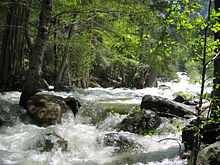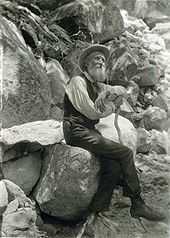John Muir Trail
| John Muir Trail | |
|---|---|
 John Muir Trail crossing a creek in the Ansel Adams Wilderness | |
| Length | 210.4 mi (338.6 km) |
| Location | California, United States |
| Trailheads |
Happy Isles trailhead, Yosemite Valley Summit of Mount Whitney |
| Use | backpacking, hiking, trail running, trail riding, pack trains |
| Elevation | |
| Elevation change | 80,000 ft (24,000 m) |
| Highest point | Mount Whitney, 14,505 ft (4,421 m) |
| Lowest point | Happy Isles trailhead, Yosemite Valley, 4,035 ft (1,230 m) |
| Hiking details | |
| Trail difficulty | Moderate to strenuous |
| Months | July to September |
| Sights | Yosemite Valley, Devils Postpile National Monument, Sierra Nevada |
| Hazards | Snowmelt, icy slopes early season, altitude |
The John Muir Trail (JMT) is a long-distance trail in the Sierra Nevada mountain range of California, passing through Yosemite, Kings Canyon and Sequoia National Parks. From the northern terminus at Happy Isles in Yosemite Valley (37°43′54″N 119°33′31″W / 37.7317°N 119.5587°W) and the southern terminus located on the summit of Mount Whitney (36°34′43″N 118°17′31″W / 36.5785°N 118.292°W), the Trail's official length is 210.4 miles (338.6 km). For almost all of its length, the trail is in the High Sierra backcountry and wilderness areas.[1] For about 160 miles (260 km), the trail, named for naturalist John Muir, follows the same footpath as the longer Pacific Crest Trail.
Route


The official length of the JMT, as stated by the United States Geological Survey (USGS), is 210.4 miles (338.6 km). From its northern terminus in Yosemite Valley, the trail runs northeast, passing south of Half Dome and then on to Tuolumne Meadows. From Tuolumne Meadows the trail turns south, running parallel to the main range of the Sierra Nevada, through Yosemite National Park, Inyo and Sierra national forests (including the John Muir Wilderness and Ansel Adams Wilderness), passing through Devils Postpile National Monument, Kings Canyon National Park, and ending on Mount Whitney in Sequoia National Park.[2] From the southern terminus of the JMT at the summit of Mount Whitney, an additional 10.6-mile (17.1 km) hike on the Mount Whitney Trail is required to reach the nearest trailhead at Whitney Portal, thus making an end-to-end traverse of the JMT effectively 221 miles (356 km).[3]
Elevation
With the exception of the first 9 miles (14 km) at the northern end climbing out of Yosemite Valley, the elevation of the JMT seldom dips below 8,000 feet (2,400 m). The trail crosses seven mountain passes in excess of 11,000 feet (3,400 m); from north to south, they are: Donohue Pass, Muir Pass, Mather Pass, Pinchot Pass, Glen Pass, Forester Pass and Trail Crest. At 13,153 feet (4,009 m), Forester Pass is the highest point along the Pacific Crest Trail and the second-highest pass along the JMT (after Trail Crest on the Mount Whitney Trail).
When the length of the JMT was calculated by the USGS, elevation gain and loss was not taken into consideration. It is estimated that, when hiking north to south, the amount of ascent of the JMT is just over 46,000 feet (14,000 m) and the total descent is just over 38,000 feet (12,000 m), for a total of about 84,000 feet (26,000 m), or almost 16 miles (26 km); however, this does not mean the total length is increased by 16 miles (26 km).
History

The idea of the trail along the backbone of the High Sierra originated with Theodore Solomons. Solomons later recalled that the concept originated in his adolescence. "The idea of a crest-parallel trail came to me one day while herding my uncle's cattle in an immense unfenced alfalfa field near Fresno. It was 1884 and I was 14."[4] He began advocating construction of the trail shortly after the Sierra Club was founded in 1892. John Muir was a founding member and first president of the Sierra Club. Solomons explored the area now known as the Evolution Basin, and traveled extensively throughout the High Sierra, exploring possible trail routes. Joseph Nisbet LeConte took up the cause in 1898 and the proposed trail was originally called the "High Sierra Trail", although that name was later given to a different trail, running in the east-west direction. LeConte spent years exploring the canyons and passes of the Kings River and Kern River, and climbing peaks along the proposed trail. Along with James S. Hutchinson and Duncan McDuffie, he pioneered a high mountain route in 1908 from Yosemite National Park to Kings Canyon, roughly along the route of the modern JMT. In 28 days, they completed a trip of 228 miles through the high mountains, including several previously unexplored sections.[5] In 1914, the Sierra Club appointed a committee to cooperate with the State of California to begin construction of the trail. John Muir died later that year, and the proposed trail was renamed in his honor.
Construction of the JMT began a year after Muir's death in 1915 with a $10,000 grant from the California legislature. State Engineer Wilbut F. McClure was responsible for selecting the final route. He secured the cooperation of the United States Forest Service, which managed and supervised much of the actual construction. The California state legislature made additional appropriations of $10,000 each in 1917, 1925, 1927 and 1929.
After the Depression began, assistance from the California state government came to an end, and there were still two difficult sections yet to be completed. One was the connection from the Kings River to the Kern River over Forester Pass, at an elevation of 13,153 feet (4,009 m). The Forester Pass section was completed in 1932 as the result of a joint effort between the Forest Service and the National Park Service. The Forest Service completed the final section at Palisade Creek (in the Palisade Group) in 1938. This section passes by the headwaters of the Middle Fork of the Kings River and over Mather Pass by the "Golden Staircase" to the headwaters of the South Fork of the Kings River. Shortly after, this section was incorporated into newly created Kings Canyon National Park. The entire project had taken 46 years to complete.[6] William Edward Colby, the first secretary of the Sierra Club, called the finished trail "a most appropriate memorial to John Muir, who spent many of the best years of his life exploring the region which it will make accessible."[7]
Hiking

The primary hiking season is usually from July through September, though snow may linger on the higher passes well into August following heavy snow years. Early season hikers – including Pacific Crest Trail thru-hikers headed north for Canada – have to contend not only with the snowpack and icy slopes near the passes, but with streams swollen with snowmelt. Trail conditions are less demanding later in the season after the snowmelt concludes, and the weather generally remains pleasant for hiking through September. Weather during the hiking season is generally sunny and dry, but afternoon thunderstorms are not uncommon. The trail is used primarily by backpackers and dayhikers, but also by runners, trail riders, and pack trains. Backpackers travelling at a generous pace usually complete the trail within three weeks.
A permit is required to hike the JMT, which is obtained from the national park or forest where the hiker begins the hike. This single permit is valid for the entire hike. Permits can be hard to obtain for JMT thru-hikers. The Whitney Portal end of the JMT has a lottery for wilderness permits, and hikers starting in Yosemite face competition with other backpackers simply wanting to camp overnight while hiking Half Dome or to Tuolumne Meadows. Backpackers entering the Sierra backcountry on multi-day trips are generally required to carry their food in approved hard-sided storage containers known as bear canisters to protect their food and other scented items from theft by black bears, which are common in the region.
About 75-90 percent of hikers hike north to south, from Yosemite Valley to Mt. Whitney.[8] There are advantages to starting in Yosemite Valley and hiking south. Although there is a significant net altitude gain this way, starting at a lower altitude allows the hiker time to acclimatize to the elevations of the trail rather than immediately having to tackle a 6,000-foot (1,800 m) climb to the summit of Mount Whitney. In addition, there are several resupply points convenient to the JMT during its northern half (Tuolumne Meadows, Reds Meadow, Vermillion Valley Resort, Muir Trail Ranch), allowing the hiker to carry a lighter food load early in the hike and also to exit the trail easily if problems arise. The southern half of the JMT is more remote and generally higher in elevation, thus making it more appropriate for the second half of the hike when maximum conditioning has been attained.
See also
Notes
- ↑ The trail passes near a road only at the northern terminus, in Tuolumne Meadows in Yosemite National Park ( See Winnett 1970, pp. 39–43) and at Red's Meadow near Devils Postpile National Monument
- ↑ Johnson 1971, pp. 160–161
- ↑ Wenk 2008, p. 1
- ↑ Winnett 2001, front paper
- ↑ Parsons 1947, p. 16
- ↑ Starr 1947, pp. 48–50
- ↑ Cohen 1988, p. 37
- ↑ Wenk 2008, p. 5
References
- Castle, Alan (2004). The John Muir Trail. Milnthorpe: Cicerone. ISBN 1-85284-396-9.
- Cohen, Michael P. (1988). The History of the Sierra Club 1892 - 1970. San Francisco: Sierra Club Books. ISBN 0-87156-732-6.
- Johnson, Paul C. (1971). Sierra Album. Garden City, NY: Doubleday & Co. ISBN 0-385-04832-7.
- Parsons, Harriet (1947). "Mountaineering". In David R. Brower. Sierra Club: A Handbook. San Francisco: Sierra Club.
- Starr, Walter A. (November 1947). "Trails". Sierra Club Bulletin (San Francisco: Sierra Club) 32 (10).
- Starr, Walter A. Jr.. Starr’s Guide to the John Muir Trail and the High Sierra Region. San Francisco: Sierra Club Books. ISBN 0-87156-172-7.
- Wenk, Elizabeth; Morey, Kathy (2008). The John Muir Trail: The essential guide to hiking America's most favorite trail. Berkeley: Wilderness Press. ISBN 0-89997-436-8.
- Winnett, Thomas (1970). High Sierra Hiking Guide #4: Tuolumne Meadows. Berkeley: Wilderness Press. ISBN 0-911824-10-3.
- Winnett, Thomas; Morey, Kathy (2001). Guide to the John Muir Trail (Third ed.). Berkeley, CA: Wilderness Press. ISBN 0-89997-221-7.
External links
- www.evansdp.com Photo and video Journal for the entire John Muir Trail
- Guide to the John Muir Trail by the Pacific Crest Trail Association
- John Muir Trail planning info
- John Muir Trail topographic maps
- John Muir Trail Journals and Photography
- evansdp.com for more John Muir Trail Info
| |||||||||||||||||||||||||||||
| |||||||||||||||||


